|
The last collaborative work by Komar and Melamid, the project "Symbols of the Big Bang" was shown in New York City at Yeshiva University Museum in 2002-2003 (see catalog "Komar and Melamid; Symbols of the Big Bang" by Anthony Julius, Reba Wulkan, and Ori Z Soltes).
At the end of 2003, Vitaly Komar created this website and established "Former Komar and Melamid's Art Studio Archive". In 2004, V. Komar started to work on his individual project "The Three-Day Weekend". In 2005, this work was shown at the Ronald Feldman Gallery, New York; Ben Uri Gallery, Jewish Museum, London; Matthew Bown Gallery, London, UK; and Humanity Gallery in Cooper Union School of Art and Design, New York (see catalog by Dore Ashton and Andrew Weinstein, and artist statement).
Since 2005, This website's chronology is dedicated to selected works by V. Komar.
Hermitage Museum Foundation Newsletter. February 2011 Volume 2, Issue One

|
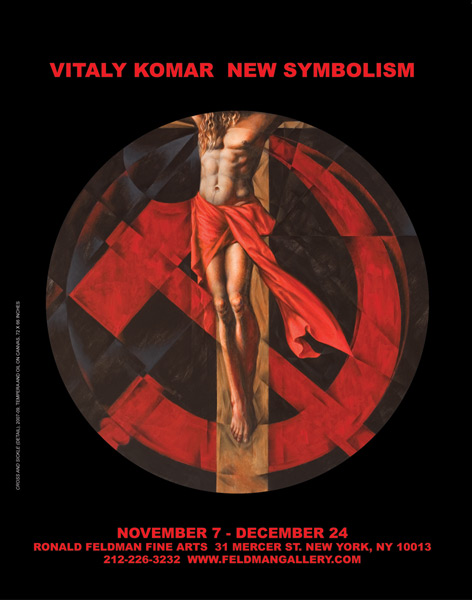
|
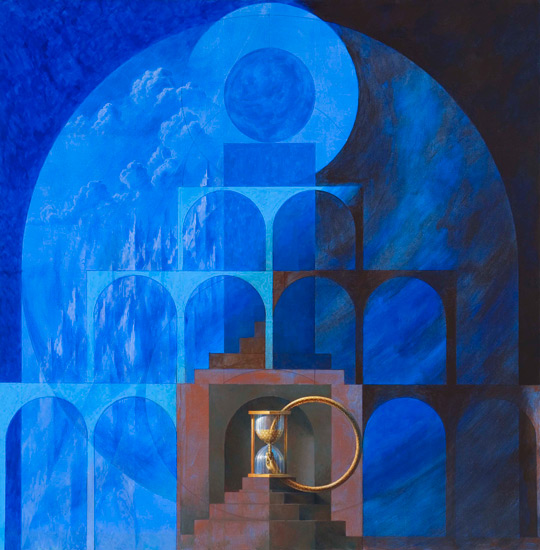 |
Time as a Tail of Ouroboros
|
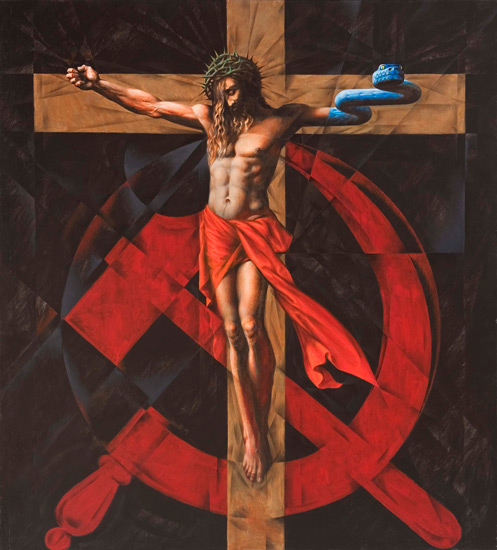 |
Cross and Sickle
|
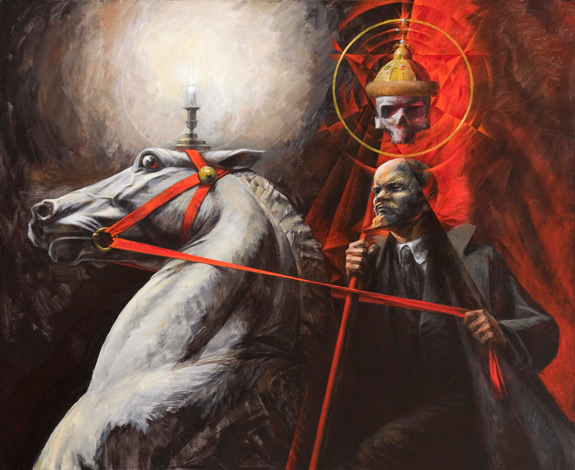 |
Lenin with Crown
|
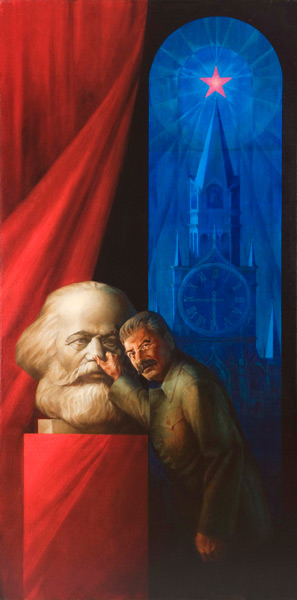 |
Stalin Contemplating a Bust of Marx
|
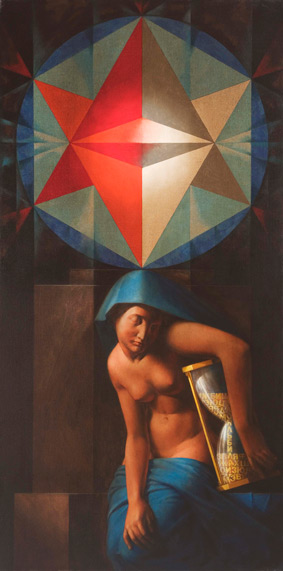 |
Russian Alphabet in an Hourglass
|
 |
Serpent of Brass and Second Commandment
|
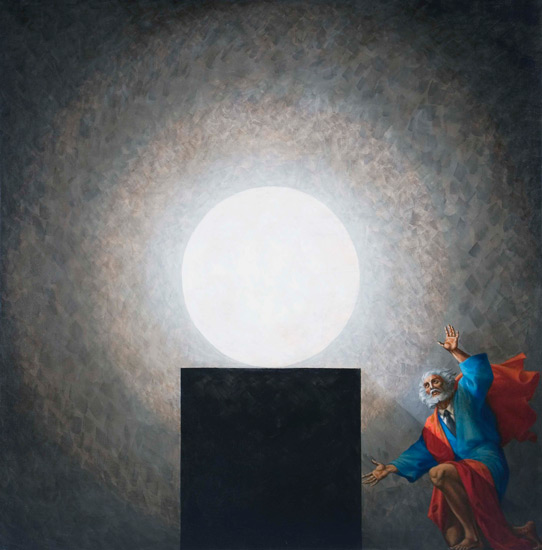 |
Last Days of Job
|
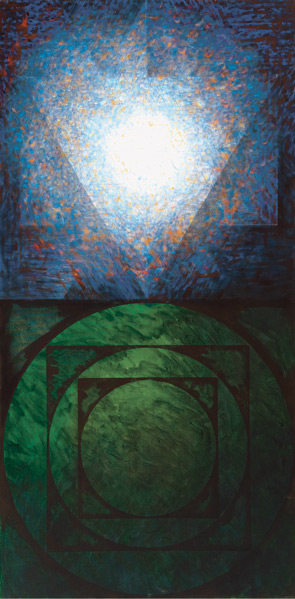 |
Sky and Earth
|
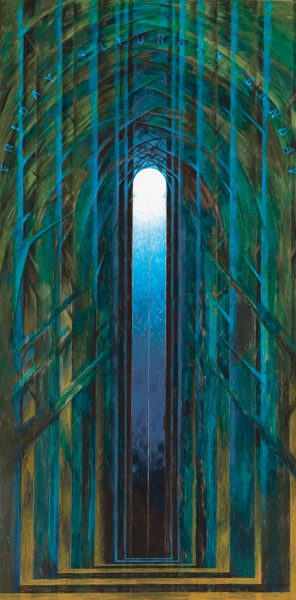 |
Forest as a Temple
|
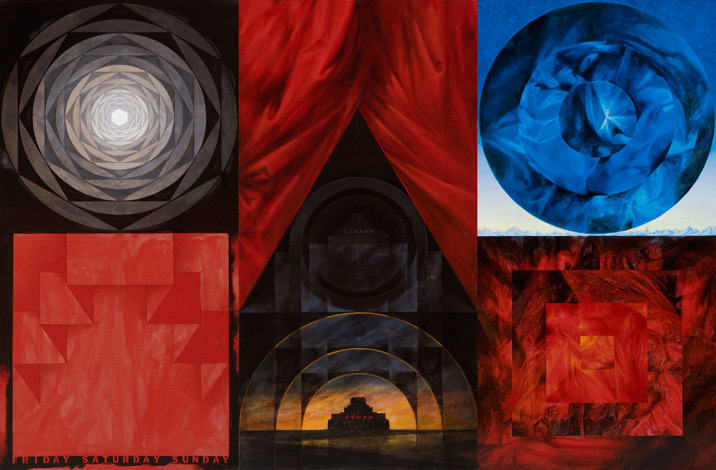 |
Landscape with Lenin's Tomb (Triptych)
|
|
Vitaly Komar. New Symbolism
New Symbolism is intended to suggest a movement. Even if it remains one artist's movement, it may work toward restoring a sundered connection between art and certain historical and timeless myths. In New Symbolism, symbols akin to mandalas and heraldic emblems are conceptual signifiers that coexist seamlessly with painting's reverie.
Its images are visions of a yet unborn, unpronounceable word. They're related not only to the art of the Pre-Raphaelites and 19th-century Symbolists but, to a greater extent, to syncretic symbols that, thousands of years ago, unified the origin of written language and art. These works may be termed "conceptual symbolism" or "proto-symbolism".
With this project, I would like to approach the near-absurd syncretism of state symbols. I recall walking to UN Plaza to watch the removal of the Soviet flag. It was the fall of 1991 and leaves were falling in New York, but as I looked at the hammer and sickle I saw instead the old symbols of vanity and life's evanescence: the hourglass and the skull. I stood for a long time under those flags - canvases at an installation juxtaposing abstract and figurative images, political heraldry and transcendental mandalas.
The consequences of world wars, of social and scientific breakthroughs, have eroded the connection between fragments of what once was a continuous experience of the world. In these conditions I turn to visual symbols and their mysterious quality of bringing together unrelated images and concepts. Today, this magical gravitation gives me a feeling of lightness and hope that art may yet resist the universe's scientifically-proven tendency to expand - the phenomenon that someday will bring about a starless sky, with all of its unproven consequences for the soul.
|
|
Виталий Комар. Новый Символизм.
Новый Символизм - это проект создания течения. Даже если это течение одного художника, оно может восстановить утраченную связь искусства с историческими и вневременными мифами. Новый Символизм создает символы, подобные мандалам и геральдическим эмблемам, которые как концептуальные знаки соединяются с живописной грезой.
Образы Нового Символизма - это видения еще не рожденного, непроизносимого слова. Они концептуальны и сродни не только искусству прерафаэлитов и символистов XIX-го века, но, в большей степени, древним синкретическим символам, которые тысячи лет назад обьединяли происхождение письменности и искусства. Поэтому эти работы можно назвать и "концептуальным символизмом", и "протосимволизмом".
В своем проекте я хотел бы приблизиться к граничащему с абсурдом синкретизму государственных символов. Помню, я пришел к зданию ООН увидеть, как снимают советский флаг. Стояла осень 1991-го года, в Нью-Йорке опадали листья, я смотрел на серп и молот, но видел старый символ Суеты сует: песочные часы и череп. Я долго стоял перед флагами всех стран. Полотна этой инсталляции обьединяли абстрактные и фигуративные образы, политическую геральдику и трансцендентные мандалы.
Последствия мировых войн, социальных и научных революций ведут к разрушению связей между фрагментами когда-то гармонично единого мира. В этих условиях я обращаюсь к визуальным символам с их таинственными свойствами сближать далекие друг от друга образы и концепции. Эта магическая гравитация приносит мне облегчение и надежду на то, что искусство сопротивляется научно-доказанному расширению вселенной, ведущему к небу без звезд, со всеми недоказанными последствиями этого для нашей души.

|
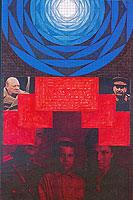
Three-Day Weekend.
June 18 - July 29, 2005
RONALD FELDMAN GALLERY
31 Mercer Street
Phone: (212) 226-3232
Fax: (212) 941-1536
NYC, NY 10013
Hours: Tues.-Sat., 10-6 pm, Mon. by appointment
Please visit Ronald Feldman Gallery on the web.
For more information about the exhibit, please visit us here and here.
VITALY KOMAR
Three-Day Weekend
Brief Description of Project.
The Three-Day Weekend , for me, is a symbol of the peaceful coexistence of different peoples and different concepts of faith and spirituality: Friday for Muslims, Saturday for Jews, and Sunday for Christians.
The idea to create ecumenical symbols in the form of Universal Mandalas originated in my childhood dreams, and continues the search of the nonconformist art of my youth. In these mandalas, I unite ancient symbols of spirituality with historical and personal images (see Artist's Statement).
At some point during my work with photographs of me and my parents, a face-mine or one of the others, appeared in the center of some of the mandalas. These accidents gave me the idea of making painted and stained glass panels with a hole or a mirror in the center of the mandala. Visitors who'd like to participate in this project can place their faces in the opening of certain mandalas, or see their reflection in the mirror in the others. I will photograph them with a Polaroid camera and make ID-like, pocket-sized mandala portraits. In this way, spectators can establish a personal connection with eternal symbols of spirituality and the concept of the Three-Day Weekend. I invite everybody to make an appointment.
The exhibition and publication of these symbols will be the initial step in the creation and promotion of a not-for-profit Three-Day Weekend Society.
Vitaly Komar: Brief Biography
Vitaly Komar was born in Moscow, USSR in 1943, graduated from the Stroganov School of Art and Design in 1967, and has been living in New York since 1978. He was one of the founders of the Sots Art movement (soviet Pop/Conceptual art) and a pioneer of multi-stylistic post-modernism (1972-73).
Vitaly Komar worked in collaboration with Alex Melamid from 1973 to 2003. In 1974, he was arrested during a performance of Art Belongs to the People and later, on September 15th, his and A. Melamid's work along with the works of other non-conformist artists was destroyed by Soviet Authorities at the open-air Bulldozer Exhibition.
Komar and Melamid can be found in Oxford's Dictionary of 20th Century Art; The Penguin Concise Dictionary of Art History; Art since the 40's; Bildende Kunst im 20 Jahrhundert; Bordas' Petit Dictionnaire Des Artistes Contemporains; Art in the Modern Era; and Phaidon's The 20th-Century Art Book. Their work is included in major art museums across the world.
They collaborated with the conceptual video artist Douglas Davis on Questions New York/Moscow in 1976 (collection of the Metropolitan Museum of Art, New York); with Fluxus musician Charlotte Moorman on Passport in 1976 (Ronald Feldman Gallery); with Pop Artist Andy Warhol on We Buy and Sell Souls in 1978-79 (private collection, Moscow); with dozens of artists and Soviet monuments on Monumental Propaganda in 1993 (traveling show, Independent Curators Inc.); with the masses and Marttila & Kiley Poll Company on Most Wanted and Most Unwanted Paintings in 1994; with composer Dave Soldier on an opera about Washington, Lenin and Duchamp, Naked Revolution in 1997 (Walker Art Center, Minneapolis and The Kitchen, New York);with painter Renee the elephant in 1995 and with photographer Mikki the Chimpanzee in 1998 (Russian pavilion at Venice Biennale, 1999).
After the Symbols of the Big Bang (quest for spirituality in science and natural forces) exhibited at the Yeshiva University Museum (New York, 2002-03) the artist started the Three-Day Weekend uniting symbols of different faiths and concepts of spirituality with childhood photographs of him and his parents. This deeply personal work marked the end of his collaboration with Alex Melamid, but the artist understands the concept of artistic collaboration very broadly. "I continue collaborating with art history" said Vitaly Komar, "with the nonconformist art of my youth and its unfulfilled dreams and experiments."
|











